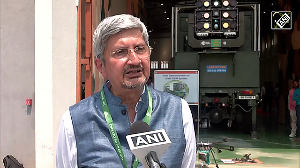Instead of just criticising Modi for having chickened out from unleashing tough reforms, it would be equally important to reflect on the past successive governments' failure to create a basic structure that is necessary if an exit policy were to be introduced, says A K Bhattacharya.

More than two decades ago, during the early years of economic reforms of the 1990s, the idea of an exit policy for labour was mooted and then buried quite unceremoniously.
Those keen that the P V Narasimha Rao government should speed up reforms had pressed hard on giving industry the freedom to hire and fire employees.
But Manmohan Singh, finance minister at that time, argued against the introduction of an exit policy on the ground that the country was not yet ready for such a policy.
In a country where most people consider themselves lucky to get even one job in their lifetime, it was premature to think of an exit policy.
Nobody talked of an exit policy again, at least as long as Singh was the finance minister.
Indeed, no successive government thought of reviving the idea of an exit policy.
The Atal Bihari Vajpayee government had pursued privatisation quite vigorously and sold a few important public sector units like Indian Petrochemicals Corporation Limited and Videsh Sanchar Nigam Limited to bidders from the private sector.
But it remained non-committal on the question of an exit policy. And, of course, during the United Progressive Alliance government of Manmohan Singh, there was no talk of an exit policy for the 10 years that it ruled at the Centre.
The installation of the Narendra Modi government in 2014 revived hopes of an exit policy through changes in the Industrial Disputes Act so that industry up to a certain size could sack employees without obtaining any approval from the government and other state-owned or local authorities.
For much of the first two years of the Modi government, the widely held view was that an exit policy would be brought in eventually, even though such reforms would be delayed.
That delay was attributed to the government's lack of majority in the Rajya Sabha. Even if the Lok Sabha would pass the necessary changes in the Industrial Disputes Act, the fear was that the Opposition led by the Congress could defeat such a legislative initiative in the Rajya Sabha.
Hence, the states ruled by the Bharatiya Janata Party (BJP) were encouraged to pass such labour reform laws pending a central law on the matter.
Indeed, Rajasthan moved ahead to bring in labour policy reforms and Madhya Pradesh, too, planned similar changes in the law.
But what Modi told The Wall Street Journal on the eve of his government completing two years last week is likely to force a review of all such assessments.
Modi said the policy of hire and fire was a Western idea. He went even a step further in defence of the public sector, virtually rejecting the idea of privatisation.
Many questions arise from what Modi said about an exit policy and privatisation.
If privatisation is indeed not on the government's agenda, why did the Union Budget for two successive years propose the strategic sale of public sector units?
Is there a political disconnect within the government - what the Budget proposes is not necessarily endorsed by the prime minister?
And is that why, in spite of a budgetary promise, no strategic sale has happened as yet?
Or is it a ploy of political management of unpopular decisions like privatisation? Either way, this is a deeply disturbing situation.
More importantly, why is it that the government's political leaders continue to be shy of an exit policy for labour after more than two decades of reforms, citing almost the same reason that the idea is not acceptable in India?
Surely, two and a half decades is a long time for an economy to grow strong and mature enough to recognise the importance of an exit policy for labour and absorb the adverse political impact such a move would obviously trigger.
Instead of just criticising Modi for having chickened out from unleashing tough reforms, it would be equally important to reflect on the past successive governments' failure to create a basic structure that is necessary if an exit policy were to be introduced.
That structure should have three elements: One, make the separation package for employees to be dismissed attractive.
The option for an exit by employers will thus not be easy because of the stiff compensation costs.
Two, create a proper social safety net and a well-endowed retrenchment fund that can take care of the employees that lose their jobs.
And finally, make sure that growth of jobs becomes as important a policy priority as growth itself. Merely protecting jobs does not ensure growth in jobs.
Why only Modi? No prime minister in this country can ever bring in an exit policy unless the government first fulfils these three conditions.
Photograph: Reuters













 © 2025
© 2025